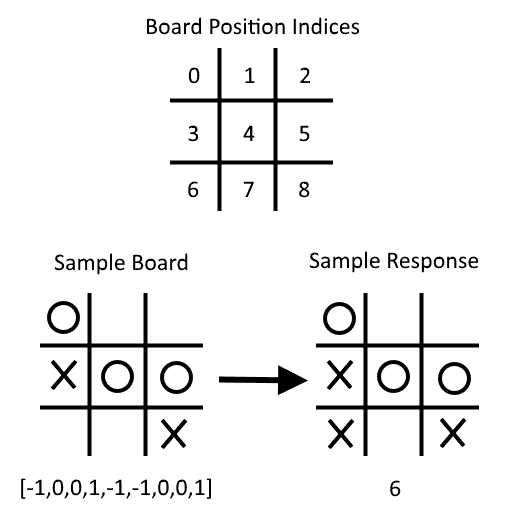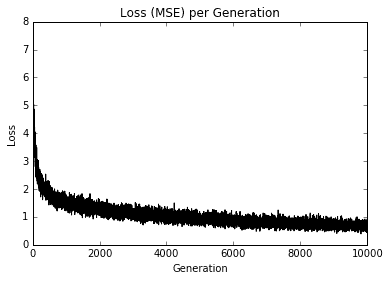# 学习玩井字棋
为了展示适应性神经网络的可用性,我们现在将尝试使用神经网络来学习井字棋的最佳动作。我们将知道井字棋是一种确定性游戏,并且最佳动作已经知道。
## 做好准备
为了训练我们的模型,我们将使用一系列的棋盘位置,然后对许多不同的棋盘进行最佳的最佳响应。我们可以通过仅考虑在对称性方面不同的棋盘位置来减少要训练的棋盘数量。井字棋棋盘的非同一性变换是 90 度,180 度和 270 度的旋转(在任一方向上),水平反射和垂直反射。鉴于这个想法,我们将使用最佳移动的候选棋盘名单,应用两个随机变换,然后将其输入神经网络进行学习。
> 由于井字棋是一个确定性的游戏,值得注意的是,无论谁先走,都应该赢或抽。我们希望能够以最佳方式响应我们的动作并最终获得平局的模型。
如果我们将 Xs 注释为 1,将 Os 注释为-1,将空格注释为 0,则下图说明了我们如何将棋盘位置和最佳移动视为一行数据:
Figure 9: Here, we illustrate how to consider a board and an optimal move as a row of data. Note that X = 1, O = -1, and empty spaces are 0, and we start indexing at 0
除了模型损失,要检查我们的模型如何执行,我们将做两件事。我们将执行的第一项检查是从训练集中删除位置和最佳移动行。这将使我们能够看到神经网络模型是否可以推广它以前从未见过的移动。我们将评估模型的第二种方法是在最后实际对抗它。
可以在此秘籍的 GitHub 目录中找到可能的棋盘列表和最佳移动: [https://github.com/nfmcclure/tensorflow_cookbook/tree/master/06_Neural_Networks/08_Learning_Tic_Tac_Toe](https://github.com/nfmcclure/tensorflow_cookbook/tree/master/06_Neural_Networks/08_Learning_Tic_Tac_Toe) 和 Packt 仓库: [https://github.com/PacktPublishing/TensorFlow-Machine-Learning-Cookbook-Second-Edition](https://github.com/PacktPublishing/TensorFlow-Machine-Learning-Cookbook-Second-Edition) 。
## 操作步骤
我们按如下方式处理秘籍:
1. 我们需要从为此脚本加载必要的库开始,如下所示:
```py
import tensorflow as tf
import matplotlib.pyplot as plt
import csv
import random
import numpy as np
import random
```
1. 接下来,我们声明以下批量大小来训练我们的模型:
```py
batch_size = 50
```
1. 为了使棋盘更容易可视化,我们将创建一个输出带 Xs 和 Os 的井字棋棋盘的函数。这是通过以下代码完成的:
```py
def print_board(board):
symbols = ['O', ' ', 'X']
board_plus1 = [int(x) + 1 for x in board]
board_line1 = ' {} | {} | {}'.format(symbols[board_plus1[0]],
symbols[board_plus1[1]],
symbols[board_plus1[2]])
board_line2 = ' {} | {} | {}'.format(symbols[board_plus1[3]],
symbols[board_plus1[4]],
symbols[board_plus1[5]])
board_line3 = ' {} | {} | {}'.format(symbols[board_plus1[6]],
symbols[board_plus1[7]],
symbols[board_plus1[8]])
print(board_line1)
print('___________')
print(board_line2)
print('___________')
print(board_line3)
```
1. 现在我们必须创建一个函数,它将返回一个新的棋盘和一个转换下的最佳响应位置。这是通过以下代码完成的:
```py
def get_symmetry(board, response, transformation):
'''
:param board: list of integers 9 long:
opposing mark = -1
friendly mark = 1
empty space = 0
:param transformation: one of five transformations on a board:
rotate180, rotate90, rotate270, flip_v, flip_h
:return: tuple: (new_board, new_response)
'''
if transformation == 'rotate180':
new_response = 8 - response
return board[::-1], new_response
elif transformation == 'rotate90':
new_response = [6, 3, 0, 7, 4, 1, 8, 5, 2].index(response)
tuple_board = list(zip(*[board[6:9], board[3:6], board[0:3]]))
return [value for item in tuple_board for value in item], new_response
elif transformation == 'rotate270':
new_response = [2, 5, 8, 1, 4, 7, 0, 3, 6].index(response)
tuple_board = list(zip(*[board[0:3], board[3:6], board[6:9]]))[::-1]
return [value for item in tuple_board for value in item], new_response
elif transformation == 'flip_v':
new_response = [6, 7, 8, 3, 4, 5, 0, 1, 2].index(response)
return board[6:9] + board[3:6] + board[0:3], new_response
elif transformation == 'flip_h':
# flip_h = rotate180, then flip_v
new_response = [2, 1, 0, 5, 4, 3, 8, 7, 6].index(response)
new_board = board[::-1]
return new_board[6:9] + new_board[3:6] + new_board[0:3], new_response
else:
raise ValueError('Method not implmented.')
```
1. 棋盘列表及其最佳响应位于目录中的`.csv`文件中,可从 github 仓库 [https://github.com/nfmcclure/tensorflow_cookbook](https://github.com/nfmcclure/tensorflow_cookbook) 或 Packt 仓库获得 [https://github.com/PacktPublishing/TensorFlow-Machine-Learning-Cookbook-Second-Edition](https://github.com/PacktPublishing/TensorFlow-Machine-Learning-Cookbook-Second-Edition)。我们将创建一个函数,它将使用棋盘和响应加载文件,并将其存储为元组列表,如下所示:
```py
def get_moves_from_csv(csv_file):
'''
:param csv_file: csv file location containing the boards w/ responses
:return: moves: list of moves with index of best response
'''
moves = []
with open(csv_file, 'rt') as csvfile:
reader = csv.reader(csvfile, delimiter=',')
for row in reader:
moves.append(([int(x) for x in row[0:9]],int(row[9])))
return moves
```
1. 现在我们需要将所有内容组合在一起以创建一个函数,该函数将返回随机转换的棋盘和响应。这是通过以下代码完成的:
```py
def get_rand_move(moves, rand_transforms=2):
# This function performs random transformations on a board.
(board, response) = random.choice(moves)
possible_transforms = ['rotate90', 'rotate180', 'rotate270', 'flip_v', 'flip_h']
for i in range(rand_transforms):
random_transform = random.choice(possible_transforms)
(board, response) = get_symmetry(board, response, random_transform)
return board, response
```
1. 接下来,我们需要初始化图会话,加载数据,并创建一个训练集,如下所示:
```py
sess = tf.Session()
moves = get_moves_from_csv('base_tic_tac_toe_moves.csv')
# Create a train set:
train_length = 500
train_set = []
for t in range(train_length):
train_set.append(get_rand_move(moves))
```
1. 请记住,我们希望从我们的训练集中删除一个棋盘和一个最佳响应,以查看该模型是否可以推广以实现最佳移动。以下棋盘的最佳举措将是在第 6 号指数进行:
```py
test_board = [-1, 0, 0, 1, -1, -1, 0, 0, 1]
train_set = [x for x in train_set if x[0] != test_board]
```
1. 我们现在可以创建函数来创建模型变量和模型操作。请注意,我们在以下模型中不包含`softmax()`激活函数,因为它包含在损失函数中:
```py
def init_weights(shape):
return tf.Variable(tf.random_normal(shape))
def model(X, A1, A2, bias1, bias2):
layer1 = tf.nn.sigmoid(tf.add(tf.matmul(X, A1), bias1))
layer2 = tf.add(tf.matmul(layer1, A2), bias2)
return layer2
```
1. 现在我们需要声明我们的占位符,变量和模型,如下所示:
```py
X = tf.placeholder(dtype=tf.float32, shape=[None, 9])
Y = tf.placeholder(dtype=tf.int32, shape=[None])
A1 = init_weights([9, 81])
bias1 = init_weights([81])
A2 = init_weights([81, 9])
bias2 = init_weights([9])
model_output = model(X, A1, A2, bias1, bias2)
```
1. 接下来,我们需要声明我们的`loss`函数,它将是最终输出 logits 的平均 softmax(非标准化输出)。然后我们将声明我们的训练步骤和优化器。如果我们希望将来能够对抗我们的模型,我们还需要创建一个预测操作,如下所示:
```py
loss = tf.reduce_mean(tf.nn.sparse_softmax_cross_entropy_with_logits(logits=model_output, labels=Y))
train_step = tf.train.GradientDescentOptimizer(0.025).minimize(loss)
prediction = tf.argmax(model_output, 1)
```
1. 我们现在可以使用以下代码初始化变量并循环遍历神经网络的训练:
```py
# Initialize variables
init = tf.global_variables_initializer()
sess.run(init)
loss_vec = []
for i in range(10000):
# Select random indices for batch
rand_indices = np.random.choice(range(len(train_set)), batch_size, replace=False)
# Get batch
batch_data = [train_set[i] for i in rand_indices]
x_input = [x[0] for x in batch_data]
y_target = np.array([y[1] for y in batch_data])
# Run training step
sess.run(train_step, feed_dict={X: x_input, Y: y_target})
# Get training loss
temp_loss = sess.run(loss, feed_dict={X: x_input, Y: y_target})
loss_vec.append(temp_loss)
```
```py
if i%500==0:
print('iteration ' + str(i) + ' Loss: ' + str(temp_loss))
```
1. 以下是绘制模型训练损失所需的代码:
```py
plt.plot(loss_vec, 'k-', label='Loss')
plt.title('Loss (MSE) per Generation')
plt.xlabel('Generation')
plt.ylabel('Loss')
plt.show()
```
我们应该得到以下每代损失的绘图:

图 10:Tic-Tac-Toe 训练组损失超过 10,000 次迭代
在上图中,我们绘制了训练步骤的损失。
1. 为了测试模型,我们需要看看它是如何在我们从训练集中删除的测试棋盘上执行的。我们希望模型可以推广和预测移动的最佳索引,这将是索引号 6.大多数时候模型将成功,如下所示:
```py
test_boards = [test_board]
feed_dict = {X: test_boards}
logits = sess.run(model_output, feed_dict=feed_dict)
predictions = sess.run(prediction, feed_dict=feed_dict)
print(predictions)
```
1. 上一步应该产生以下输出:
```py
[6]
```
1. 为了评估我们的模型,我们需要与我们训练的模型进行对比。要做到这一点,我们必须创建一个能够检查胜利的函数。这样,我们的程序将知道何时停止要求更多动作。这是通过以下代码完成的:
```py
def check(board):
wins = [[0,1,2], [3,4,5], [6,7,8], [0,3,6], [1,4,7], [2,5,8], [0,4,8], [2,4,6]]
for i in range(len(wins)):
if board[wins[i][0]]==board[wins[i][1]]==board[wins[i][2]]==1.:
return 1
elif board[wins[i][0]]==board[wins[i][1]]==board[wins[i][2]]==-1.:
return 1
return 0
```
1. 现在我们可以使用我们的模型循环播放游戏。我们从一个空白棋盘(全零)开始,我们要求用户输入一个索引(0-8),然后我们将其输入到模型中进行预测。对于模型的移动,我们采用最大的可用预测,也是一个开放空间。从这个游戏中,我们可以看到我们的模型并不完美,如下所示:
```py
game_tracker = [0., 0., 0., 0., 0., 0., 0., 0., 0.]
win_logical = False
num_moves = 0
while not win_logical:
player_index = input('Input index of your move (0-8): ')
num_moves += 1
# Add player move to game
game_tracker[int(player_index)] = 1\.
# Get model's move by first getting all the logits for each index
[potential_moves] = sess.run(model_output, feed_dict={X: [game_tracker]})
# Now find allowed moves (where game tracker values = 0.0)
allowed_moves = [ix for ix,x in enumerate(game_tracker) if x==0.0]
# Find best move by taking argmax of logits if they are in allowed moves
model_move = np.argmax([x if ix in allowed_moves else -999.0 for ix,x in enumerate(potential_moves)])
# Add model move to game
game_tracker[int(model_move)] = -1\.
print('Model has moved')
print_board(game_tracker)
# Now check for win or too many moves
if check(game_tracker)==1 or num_moves>=5:
print('Game Over!')
win_logical = True
```
1. 上一步应该产生以下交互输出:
```py
Input index of your move (0-8): 4
Model has moved
O | |
___________
| X |
___________
| |
Input index of your move (0-8): 6
Model has moved
O | |
___________
| X |
___________
X | | O
Input index of your move (0-8): 2
Model has moved
O | | X
___________
O | X |
___________
X | | O
Game Over!
```
## 工作原理
在本节中,我们通过馈送棋盘位置和九维向量训练神经网络来玩井字棋,并预测最佳响应。我们只需要喂几个可能的井字棋棋盘并对每个棋盘应用随机变换以增加训练集大小。
为了测试我们的算法,我们删除了一个特定棋盘的所有实例,并查看我们的模型是否可以推广以预测最佳响应。最后,我们针对我们的模型玩了一个示例游戏。虽然它还不完善,但仍有不同的架构和训练程序可用于改进它。
- TensorFlow 入门
- 介绍
- TensorFlow 如何工作
- 声明变量和张量
- 使用占位符和变量
- 使用矩阵
- 声明操作符
- 实现激活函数
- 使用数据源
- 其他资源
- TensorFlow 的方式
- 介绍
- 计算图中的操作
- 对嵌套操作分层
- 使用多个层
- 实现损失函数
- 实现反向传播
- 使用批量和随机训练
- 把所有东西结合在一起
- 评估模型
- 线性回归
- 介绍
- 使用矩阵逆方法
- 实现分解方法
- 学习 TensorFlow 线性回归方法
- 理解线性回归中的损失函数
- 实现 deming 回归
- 实现套索和岭回归
- 实现弹性网络回归
- 实现逻辑回归
- 支持向量机
- 介绍
- 使用线性 SVM
- 简化为线性回归
- 在 TensorFlow 中使用内核
- 实现非线性 SVM
- 实现多类 SVM
- 最近邻方法
- 介绍
- 使用最近邻
- 使用基于文本的距离
- 使用混合距离函数的计算
- 使用地址匹配的示例
- 使用最近邻进行图像识别
- 神经网络
- 介绍
- 实现操作门
- 使用门和激活函数
- 实现单层神经网络
- 实现不同的层
- 使用多层神经网络
- 改进线性模型的预测
- 学习玩井字棋
- 自然语言处理
- 介绍
- 使用词袋嵌入
- 实现 TF-IDF
- 使用 Skip-Gram 嵌入
- 使用 CBOW 嵌入
- 使用 word2vec 进行预测
- 使用 doc2vec 进行情绪分析
- 卷积神经网络
- 介绍
- 实现简单的 CNN
- 实现先进的 CNN
- 重新训练现有的 CNN 模型
- 应用 StyleNet 和 NeuralStyle 项目
- 实现 DeepDream
- 循环神经网络
- 介绍
- 为垃圾邮件预测实现 RNN
- 实现 LSTM 模型
- 堆叠多个 LSTM 层
- 创建序列到序列模型
- 训练 Siamese RNN 相似性度量
- 将 TensorFlow 投入生产
- 介绍
- 实现单元测试
- 使用多个执行程序
- 并行化 TensorFlow
- 将 TensorFlow 投入生产
- 生产环境 TensorFlow 的一个例子
- 使用 TensorFlow 服务
- 更多 TensorFlow
- 介绍
- 可视化 TensorBoard 中的图
- 使用遗传算法
- 使用 k 均值聚类
- 求解常微分方程组
- 使用随机森林
- 使用 TensorFlow 和 Keras
